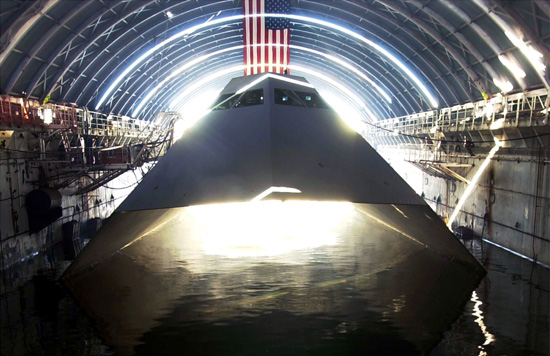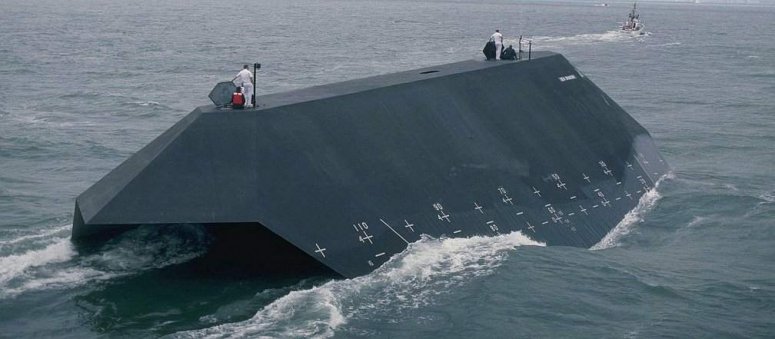The Sea Shadow was dry-docked before it ever launched beyond testing. However, its technologies were eventually applied to the lower cross-section of submarine periscopes and the radar cross-section of the Navy’s new class of destroyers.
It was in the spring of 1978 that the Skunk Works decided to extend their stealth capabilities into the realm of submarines.
The Polaroid concept… “Time out! There isn’t one thing wrong with your new camera,” said Ben Rich to a company photographer who was complaining that his Polaroid camera was defective after his shots of a model F-117 came out blurry. As explained by James C. Goodall in his book 75 Years of the Lockheed Martin Skunk Works, as it turned out, the stealthy coatings and shaping of the airplane interfered with the camera’s sonar-like device used to focus, making the images appear fuzzy.
When Rich led the Skunk Works, he was always on the prowl to find ideas to expand or exploit the stealth technologies they were developing. After the incident with the Polaroid, Rich realized he could apply the stealth technology of the F-117 to a submarine, making it undetectable on sonar.
His team got right to work and bought a small model submarine, put faceted fairings on it, and tested it in a sonic chamber. Even with such a crude setup, the team members discovered that they had reduced the model’s sonar return by three orders of magnitude. Rich has said that “in the engineering game, improving anything by a single order of magnitude, ten times better, is a very big deal and usually worth a nice bottle of champagne.” Having discovered an improvement 1,000 times better, Skunk Works decided to pursue designing a stealthy sub.
The initial design consisted of a cigar-shaped hull that was shielded by an outer wall of flat, angular surfaces. These surfaces could bounce sonar signals away and also muffle the engine sounds and the internal noises of crewmen inside the vessel. The Skunk Works team ran numerous acoustical tests in special sound-measuring facilities and obtained dramatic improvements.

Armed with high hopes, Rich took the design and test results to the Pentagon office of a Navy captain in charge of submarine research and development. To put it lightly, the submarine captain was not convinced the Sea Shadow was right for them. Moreover, he was concerned that the design would cost the Navy two or three knots of speed. Even after rebutting the captain’s complaint by explaining that they would gain invisibility from the enemy, Rich left that trip empty-handed. Just as all hope for this project was lost, a fellow Skunk Works engineer who had just returned from Pearl Harbor informed Rich that he’d seen the Small Water Area Twin Hull (SWATH), a prototype catamaran-style Naval ship. As this had proven to be quicker than a conventional ship and amazingly stable in heavy seas, Rich decided that the SWATH was the perfect model for a stealthy ship. With this news, Rich traveled back to Washington to meet with Defense Undersecretary Bill Perry in a discussion originally planned for the F-117. Dr. Perry was intrigued by Rich’s idea for a model stealth ship and authorized a contract through DARPA for the Skunk Works to test the effects of stealth shaping and coatings on surface vessels and the effects of seawater on radar-absorbing iron ferrite coatings.
At the time, one of the biggest threats against US surface vessels was the Soviet RORS satellite, which used X-band radar. Knowing that shape was the key to defeating such radar, Rich and his team designed the ship using severe flat planes of 45-degree angles that bore a strong resemblance to the Nighthawk. The engineering team, led by Ugo Cody, tested the concept by taking the ship to an ancient lakebed deep within Death Valley, California. There, it filled a 100-by-80-foot plastic swimming pool and rigged a radar system that duplicated the Soviet radar satellite. Testing proved successful, resulting in additional funding from the Navy to create the prototype of the Sea Shadow. However, the Ocean division of Lockheed caught wind of the project and managed to convince Rich to pass the project to them, as they were in dire need of new work at the time. Part of this agreement allowed chief engineer Ugo Cody to continue with the program to ensure that the shipbuilders didn’t compromise stealth for performance.
During its first sea trials in 1984, the crew suffered unexpectedly large wakes that were easy to spot on radar and from the air, which was baffling. Not long after, the crewmembers discovered that the motor propellers were installed backward. They quickly corrected the problem and continued to make progress, proving the ship’s capabilities. Nevertheless, the Sea Shadow was dry-docked before it ever launched beyond testing. However, its technologies were eventually applied to the lower cross-section of submarine periscopes and the radar cross-section of the Navy’s new class of destroyers.
75 Years of the Lockheed Martin Skunk Works is published by Osprey Publishing and is available to order here.

Photo by U.S. Navy

